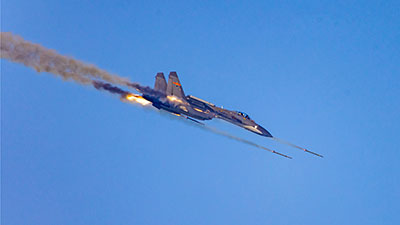Feature: Avian flu hits U.S. West from wilderness to grocery

Photo taken on Jan. 10, 2023 shows that shelves of a grocery store are bare of eggs in Westminster, Colorado, the United States. (Photo by Peter Mertz/Xinhua)
DENVER, the United States, Jan. 10 (Xinhua) -- Egg shortages and skyrocketing prices at grocery stores continue to impact American consumers as a result of the historic avian flu that is spreading rapidly among wild birds and has triggered the killing of millions of poultry.
"We have never seen anything like the enormity of this outbreak," Michael Tincher with the Rocky Mountain Raptor Program (RMRP) told The Colorado Sun newspaper on Monday. RMRP is a group of a dozen scientists who work toward protecting and saving wild birds of prey.
Colorado's worst-ever avian flu outbreak has now resulted in nearly 6.4 million poultry deaths and is increasingly crossing over into wild birds and killing bald eagles and other precious raptors, the newspaper reported, adding "wildlife watchers call the event 'the stuff of bad dreams.'"
Last week, the United States Department of Agriculture (USDA) defined on its website the recent bird flu as Highly Pathogenic Avian Influenza (HPAI) and warned poultry producers that "wild birds can be infected and show no signs of illness. They can carry the disease to new areas when migrating, potentially exposing domestic poultry to the virus."
HPAI has been detected in all 50 U.S. states, with Colorado, Utah, North Dakota, Oregon and California in the top 10 states having confirmed deaths of wild birds, although Florida, with its abundant coastline and waterfowl, leads the country in bird deaths with 379, according to USDA data.
Hundreds of wild bird deaths may not sound like many, but experts said the numbers being reported are "just a small fraction" of birds dying in the wild.
"Wildlife officials say they are overwhelmed by reports of carcasses in the wild and have limited testing of dead birds in order to concentrate efforts in the most impacted areas," the newspaper said.
Calling the current global avian outbreak "the Covid of Bird Flus," Tincher told Xinhua that initial keys toward combating the plague are education and awareness, and "not about creating a panic."
"When Covid hit, we didn't know anything about it, so we need to be patient," he said. "We need to play the long game and see how it carries out."
Wild birds affected by the virus cover the gamut of wild water fowl from the White Pelican in the south to the Snow Goose in the North, and include the Red-Tailed Hawk, the Mallard, and the Bald Eagle, the legendary symbol of America's heritage.
Last month, Colorado Parks and Wildlife (CPW) officials were dismayed that the current blight had killed a tagged and tracked Bald Eagle, one of the state's "resurgent but still tenuous population of nesting bald eagles totaling 250 to 300 pairs statewide," CBS Colorado reported.
"It's definitely somewhat demoralizing, especially to be losing these numbers of birds and in so many locations," CPW researcher Reesa Conrey told the media.
Meanwhile, local markets across the West are suffering from the bird flu pandemic.
"The mass slaughter of egg-laying flocks has decimated the commercial egg market in the state," The Colorado Sun added, adding every major egg producer in Colorado has been hit hard since the outbreak escalated again last month.
"Consumers don't realize that this hike in egg prices is not due to inflation, but due to worst avian flu outbreak on record," Tincher said, noting that the "Highly Pathogenic" classification of the illness sets it aside from all others, ever.
Egg prices doubled in 2022, according to the Consumer Price Index (CPI) and thus far 2023, consumers are facing more egg hikes.
"Ten Dollars for a dozen eggs, that's absolutely ridiculous," Erma Rouse, a Circle K employee in North Denver, told Xinhua on Tuesday, whose small convenience store had no eggs for sale on that day.
Rouse was aware that the avian outbreak has caused egg shortages and price jumps, telling Xinhua that she "won't eat them again until the price drops."
"We get calls from people who tell us a nearby raptor or eagle is acting funny or dying, and the first question we ask them is if they have any poultry nearby," Tincher told Xinhua.
Many poultry farmers who live in rural areas are not fully aware that the ongoing avian outbreak, which has been ebbing and increasing in severity for almost a year, is possibly being spread more by wild birds carrying the disease.
Not only Colorado's major producers have to destroy flocks of egg-laying chickens, thousands of small chicken operators and citizens who eat their own eggs or sell them in small quantities are also feeling the pinch.
Last March, a commercial flock of 2.75 million chickens in Wisconsin "had to be culled," Reuters reported, and in April, "U.S. egg factory roasts 5.3 million chickens in avian flu cull," The Guardian's headline read.
The San Francisco Chronicle reported Tuesday that "bay area restaurants are paying double for eggs as avian flu clutches supply."
"An avian flu outbreak that has choked egg supply and faced grocery store shoppers in California and across the country with empty shelves and high prices has also hit restaurants," the article noted.
Bay Area restaurant operators "now pay more than 100 U.S. dollars per case and that producer prices for eggs were up more than 280 percent in one year as of November," the report said, using the most recent months for which the Bureau of Labor Statistics data was available.
Photos
Related Stories
- Classified documents found at Biden think tank
- U.S. House adopts rules package after dysfunctional opening week
- American dream or American nightmare?
- Biden invites Brazilian president to visit U.S. in wake of violence
- 2022 witnesses chaotic situation, growing imbalances in U.S. society
- Interview: Former Bolivian foreign minister calls U.S. political model "outdated"
Copyright © 2023 People's Daily Online. All Rights Reserved.









